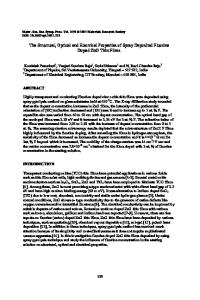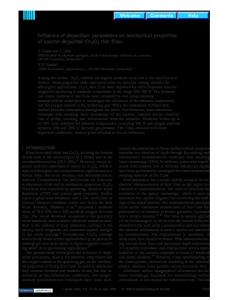The Impact of Deposition Parameters on the Optical and Compositional Properties of Er Doped SRSO Thin Films Deposited by
- PDF / 231,098 Bytes
- 5 Pages / 612 x 792 pts (letter) Page_size
- 73 Downloads / 240 Views
V5.7.1/FF5.7.1
The Impact of Deposition Parameters on the Optical and Compositional Properties of Er Doped SRSO Thin Films Deposited by ECR-PECVD Michael Flynn1, Jacek Wojcik1, Subhash Gujrathi2, Edward Irving1 and Peter Mascher1 1) Centre for Electrophotonic Materials and Devices, Department of Engineering Physics, McMaster University, Hamilton, Canada 2) ) Groupe de recherche en physique et technologie des couches minces, Lab. René -J.-A. Lévesque, Département de Physique, Université de Montréal, Montréal, Canada Abstract Silicon rich silicon oxide films were fabricated by electron cyclotron resonance plasma enhanced chemical vapor deposition (ECR-PECVD). The films were doped in situ using an organometallic precursor. Optical measurements show that the refractive indices of the films are determined by the silane to oxygen flow rate ratio used during the depositions. The erbium content as measured by elastic recoil detection (ERD) is also strongly dependent on the oxygen flow rate, with more erbium being incorporated in the more highly oxygenated films. The erbium content was also found to vary inversely with plasma power, which did not have a significant effect on the silicon to oxygen ratio. This allows the erbium and excess silicon levels of the films to be controlled independently. Introduction Silicon rich silicon oxide (SRSO) has attracted considerable attention in recent years due to its interesting optical properties. When this material is annealed the excess Si forms nanocrystalline precipitates which, unlike bulk silicon, emit light when excited either optically or electrically [1,2]. Furthermore, when doped with erbium, there is a highly efficient energy transfer from the nanocrystals to the rare earth ion, leading to strong 1.5µm emissions. The development of a silicon-based emitter, which is compatible with standard CMOS processing would allow for the development of highly integrated monolithic photonic circuits. Erbium can be introduced into thin films of SRSO either post-deposition by ion implantation [3] or during the SRSO deposition by sputtering a metallic erbium source [4]. A third means of doping is to use an organometallic erbium precursor which has been used to produce erbium doped Si films [5]. In this paper we discuss the characterization of SRSO films deposited by electron cyclotron resonance plasma enhanced chemical vapor deposition (ECR-PECVD) doped during deposition using Er(TMHD)3. The relationship between the process parameters and the film composition is explored. Experimental Details The films used in this study were deposited using an ECR-PECVD system that has been described elsewhere [6]. The erbium source, Er(TMHD)3 (Alfa Aesar), was vaporized in a stainless steel cell and supplied to the deposition chamber by an argon carrier gas. The erbium cell temperature was varied between 100 and 140 ºC. The oxygen flow rate was varied between 40 and 64sccm, and the microwave power was adjusted from 500 to 800W. Silane (SiH4) was
V5.7.2/FF5.7.2
used as the silicon source and O2 as the ox
Data Loading...











